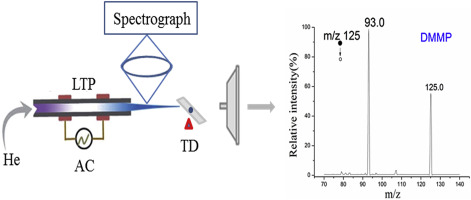当前位置:
X-MOL 学术
›
Int. J. Mass Spectrom.
›
论文详情
Our official English website, www.x-mol.net, welcomes your
feedback! (Note: you will need to create a separate account there.)
Direct detection of chemical warfare agent simulants in soil by thermal desorption-low temperature plasma-mass spectrometry
International Journal of Mass Spectrometry ( IF 1.6 ) Pub Date : 2020-05-01 , DOI: 10.1016/j.ijms.2020.116320 Baoqiang Li , Jinglin Kong , Liu Yang , Lin Zhang , Zhongyao Zhang , Cuiping Li
International Journal of Mass Spectrometry ( IF 1.6 ) Pub Date : 2020-05-01 , DOI: 10.1016/j.ijms.2020.116320 Baoqiang Li , Jinglin Kong , Liu Yang , Lin Zhang , Zhongyao Zhang , Cuiping Li

|
Abstract For rapid, accurate and real-time detection of trace chemical warfare agents in soil, direct detection of chemical warfare agent simulants in soil by thermal desorption-low temperature plasma ionization-mass spectrometry was developed. Multi-factor analysis of variance was used to quantitatively analyze the factors affecting the ionization efficiency of low temperature plasma based on the emission spectra of the plasma flame. The experimental parameters including the distance between low temperature plasma outlet and thermal desorption device, the flow rate of discharge gas, the temperature of ion source, the thermal desorption temperature and different solvents were optimized. Dimethyl methylphosphonate (DMMP, G-series nerve agent simulant), tributyl phosphate (TBP, V-series nerve agent simulant) and 2-Chloroethyl ethylsulfide (CEES, H-series blister agent simulant) were desorbed and ionized, forming the typical positive ions of [DMMP + H]+, [DMMP-HOCH3+H]+, [TBP + H]+, [TBP-3(C4H8)+H]+ and [CEES-Cl]+, [CEES- C2H4Cl]+. The ions were analyzed using the multiple reaction monitoring (MRM) of triple quadrupole mass spectrometer. Detection limit of the method was 5 pg for DMMP (m/z 125→93, S/N>3:1), 5 pg for TBP (m/z 267→99, S/N>3:1) and 5 ng for CEES (m/z 89→61, S/N>3:1). Trace level of CWA simulants can be directly detected with simple sample pretreatment, suggesting that the thermal desorption-low temperature plasma-mass spectrometry method is useful for quick and direct detection of chemical warfare agents in soil.
中文翻译:

热解吸-低温等离子体质谱法直接检测土壤中化学战剂模拟物
摘要 为了快速、准确、实时检测土壤中的痕量化学战剂,开发了热解吸-低温等离子体电离-质谱法直接检测土壤中化学战剂模拟物。基于等离子体火焰的发射光谱,采用多因素方差分析,定量分析影响低温等离子体电离效率的因素。对低温等离子体出口与热脱附装置的距离、放电气体流量、离子源温度、热脱附温度和不同溶剂等实验参数进行了优化。甲基膦酸二甲酯(DMMP,G 系列神经毒剂模拟物)、磷酸三丁酯(TBP,V 系列神经毒剂模拟物)和 2-氯乙基乙基硫醚(CEES,H系列泡罩剂模拟物)解吸电离,形成典型的正离子[DMMP+H]+、[DMMP-HOCH3+H]+、[TBP+H]+、[TBP-3(C4H8)+H] ]+ 和 [CEES-Cl]+、[CEES-C2H4Cl]+。使用三重四极杆质谱仪的多反应监测 (MRM) 分析离子。该方法的检测限为 DMMP(m/z 125→93,S/N>3:1)5 pg,TBP(m/z 267→99,S/N>3:1)5 pg 和 5 ng CEES (m/z 89→61, S/N>3:1)。通过简单的样品预处理可以直接检测痕量 CWA 模拟物,这表明热解吸-低温等离子体质谱法可用于快速、直接检测土壤中的化学战剂。[TBP-3(C4H8)+H]+ 和 [CEES-Cl]+、[CEES-C2H4Cl]+。使用三重四极杆质谱仪的多反应监测 (MRM) 分析离子。该方法的检测限为 DMMP(m/z 125→93,S/N>3:1)5 pg,TBP(m/z 267→99,S/N>3:1)5 pg 和 5 ng CEES (m/z 89→61, S/N>3:1)。通过简单的样品预处理可以直接检测痕量 CWA 模拟物,这表明热解吸-低温等离子体质谱法可用于快速、直接检测土壤中的化学战剂。[TBP-3(C4H8)+H]+ 和 [CEES-Cl]+、[CEES-C2H4Cl]+。使用三重四极杆质谱仪的多反应监测 (MRM) 分析离子。该方法的检测限为 DMMP(m/z 125→93,S/N>3:1)5 pg,TBP(m/z 267→99,S/N>3:1)5 pg 和 5 ng CEES (m/z 89→61, S/N>3:1)。通过简单的样品预处理可以直接检测痕量 CWA 模拟物,这表明热解吸-低温等离子体质谱法可用于快速、直接检测土壤中的化学战剂。
更新日期:2020-05-01
中文翻译:

热解吸-低温等离子体质谱法直接检测土壤中化学战剂模拟物
摘要 为了快速、准确、实时检测土壤中的痕量化学战剂,开发了热解吸-低温等离子体电离-质谱法直接检测土壤中化学战剂模拟物。基于等离子体火焰的发射光谱,采用多因素方差分析,定量分析影响低温等离子体电离效率的因素。对低温等离子体出口与热脱附装置的距离、放电气体流量、离子源温度、热脱附温度和不同溶剂等实验参数进行了优化。甲基膦酸二甲酯(DMMP,G 系列神经毒剂模拟物)、磷酸三丁酯(TBP,V 系列神经毒剂模拟物)和 2-氯乙基乙基硫醚(CEES,H系列泡罩剂模拟物)解吸电离,形成典型的正离子[DMMP+H]+、[DMMP-HOCH3+H]+、[TBP+H]+、[TBP-3(C4H8)+H] ]+ 和 [CEES-Cl]+、[CEES-C2H4Cl]+。使用三重四极杆质谱仪的多反应监测 (MRM) 分析离子。该方法的检测限为 DMMP(m/z 125→93,S/N>3:1)5 pg,TBP(m/z 267→99,S/N>3:1)5 pg 和 5 ng CEES (m/z 89→61, S/N>3:1)。通过简单的样品预处理可以直接检测痕量 CWA 模拟物,这表明热解吸-低温等离子体质谱法可用于快速、直接检测土壤中的化学战剂。[TBP-3(C4H8)+H]+ 和 [CEES-Cl]+、[CEES-C2H4Cl]+。使用三重四极杆质谱仪的多反应监测 (MRM) 分析离子。该方法的检测限为 DMMP(m/z 125→93,S/N>3:1)5 pg,TBP(m/z 267→99,S/N>3:1)5 pg 和 5 ng CEES (m/z 89→61, S/N>3:1)。通过简单的样品预处理可以直接检测痕量 CWA 模拟物,这表明热解吸-低温等离子体质谱法可用于快速、直接检测土壤中的化学战剂。[TBP-3(C4H8)+H]+ 和 [CEES-Cl]+、[CEES-C2H4Cl]+。使用三重四极杆质谱仪的多反应监测 (MRM) 分析离子。该方法的检测限为 DMMP(m/z 125→93,S/N>3:1)5 pg,TBP(m/z 267→99,S/N>3:1)5 pg 和 5 ng CEES (m/z 89→61, S/N>3:1)。通过简单的样品预处理可以直接检测痕量 CWA 模拟物,这表明热解吸-低温等离子体质谱法可用于快速、直接检测土壤中的化学战剂。











































 京公网安备 11010802027423号
京公网安备 11010802027423号